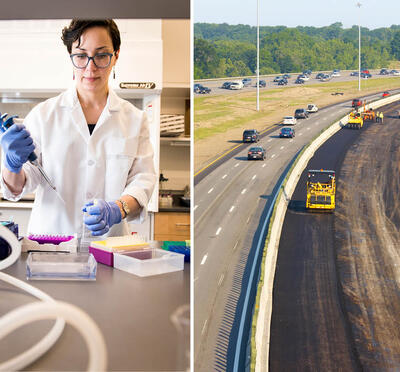Recent research at Oregon State has been adopted into national codes and standards, helping to protect public safety and health.
“Oregon State is actively engaged with local and national industry, including the transportation infrastructure manufacturing and engineering communities, and specifying agencies,” said Jason Weiss, head of the School of Civil and Construction Engineering and the Miles Lowell and Margaret Watt Edwards Distinguished Chair in Engineering. “We are looking to further extend our reach through partners in Pacific Northwest, the nation, and abroad to make major contributions in improving the climate by reducing carbon footprint while improving the health of the transportation infrastructure.”
Recent contributions to standards by Oregon State researchers:
- The American Association of State Highway and Transportation Officials Code adopted two projects by Ben Leshchinsky, associate professor of geotechnical and forest engineering, on the bearing capacity of different types of soils, which were published Journal of Geotechnical and Geoenvironmental Engineering. AASHTO is a standards setting body that publishes specifications, test protocols, and guidelines used in highway design and construction throughout the U.S.
- State agencies nationwide adopted guidelines on the use of mobile lidar in transportation applications, developed by Michael Olsen, associate professor of geomatics, and David Hurwitz, associate professor of transportation engineering, with funding from the Transportation Research Board National Cooperative Highway Research Program. More information about mobile lidar applications is available at learnmobilelidar.com.
- The AASHTO Committee on Maintenance is in the process of adopting materials and guidebooks developed by Olsen, Andre Barbosa, associate professor of structural engineering, and Haizhong Wang, associate professor of transportation engineering, for NCHRP Report 433 on assessing, coding, and marking highway structures in emergency situations as an official AASHTO guidance document.
- The Oregon Department of Transportation adopted two new traffic signal head specifications based on a project where Hurwitz served as co-investigator. The specifications provide clarity to the design of protected/permissive right-turn phasing options by including a flashing yellow arrow.
- The Portland Cement Association and AASHTO adopted new standards on the use of Portland Limestone Cement, based on research by Oregon State professors, which results in a carbon content reduction of cement by about 5% to 15%. Oregon State researchers are working with Caltrans on the potential use of PLC, which is estimated to result in a 10% carbon content reduction of cement for the deparment.
- Numerous bridges in 10 states have been built with internally cured concrete using draft specifications developed by researchers at Oregon State. This approach reduces cracking potential, and increases the life of bridges and pavement. Recently, ODOT installed its first internally cured bridge.
- Oregon State was the primary contributor to new AASHTO specifications for concrete pavements, AASHTO PP-84, which extend the life of materials by the use of field tests and numerical models that encourage the use of innovative materials with longer term durability. Additionally, Oregon State is working with the Federal Highway Administration and state highway agencies to further develop and implement these performance related standards.






